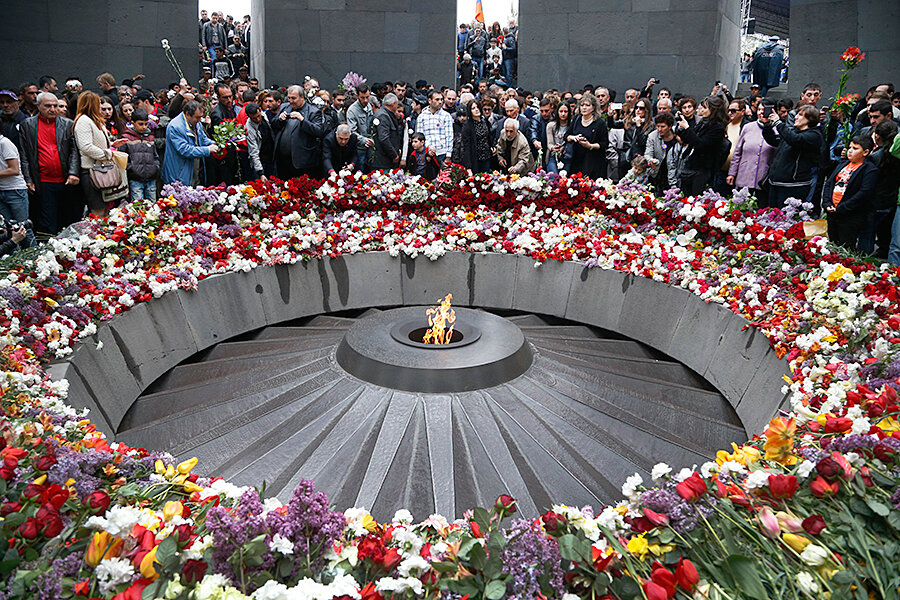Was there an Armenian genocide? It depends on Turkish 'intent.'
Loading...
As Armenians today mark the 100th anniversary of the mass killings of more than 1 million of their forebears by Ottoman Turks during World War I, debate has once again flared: Were the massacres truly a genocide?
Turkey, which condemns and expresses regret for the deaths, remains steadfast in denying that they amounted to genocide. But the international consensus has never been louder in favor of the designation. Pope Francis waded into the debate last week, calling it "the first genocide of the 20th century." German Chancellor Angela Merkel's office said on Monday that her government would support a bill recognizing the massacres as a genocide – a major reversal for Germany, which is a key trading partner to Turkey.
In one sense, the debate is primarily academic. The concept of genocide as a crime did not exist during World War I, and was not formalized until after World War II, 30 years later. As such, there's no liability at stake for the Ottoman Turks or their heirs. Rather, the main consequence would be recognition for Armenians (and a stigma upon the Ottoman Turks).
But despite growing international acceptance of describing the massacres as genocide, the debate is not simply a he-said-she-said between modern Turks and Armenians. Genocide has a very specific meaning, one that Turkey argues the Armenian massacres fail to meet.
The crime of "genocide" was first clearly defined and accepted in 1948 when the UN adopted the Convention On the Prevention and Punishment of the Crime of Genocide. It defined the crime of genocide as:
...any of the following acts committed with intent to destroy, in whole or in part, a national, ethnical, racial, or religious group, as such:
(a) Killing members of the group;
(b) Causing serious bodily or mental harm to members of the groups;
(c) Deliberately inflicting on the group conditions of life calculated to bring about its physical destruction in whole or in part;
(d) Imposing measures intended to prevent births within the group;
(e) Forcibly transferring children of the group to another group.
The convention declared that genocide, attempts to commit genocide, and being complicit in genocide were all crimes. The definition is not contentious; 146 countries have signed on to the treaty.
The Armenians were clearly a national, ethnic group, and there is ample documentation of the mass deaths they suffered under Ottoman control during World War I. So how does Turkey argue that the Armenian massacres do not fall within the UN definition?
The key element that is missing, they say, is evidence that the Ottoman Empire had "intent to destroy" the Armenians.
The existent case law on genocide predominantly interprets "intent to destroy" as meaning what lawyers call "specific intent." That is, those who committed the crime didn't simply intend to act they way they acted, but rather that they intended a specific result as well. It's like the difference between firing a gun and firing a gun to kill a specific person. The former was an intentional act, but it wasn't necessarily meant to result in that specific person's death. The latter was specifically aimed at an end result of that person's death.
A good example is the difference between the crimes of murder and manslaughter. In both cases, someone has died. But it is only the first case where there was a targeted intent to kill someone – the latter may have been a reckless accident.
In essence, Turkey argues that what happened to the Armenians during the war was more like manslaughter than murder. As the Turkish Foreign Ministry argues on its website, "no direct evidence has been discovered demonstrating that any Ottoman official sought the destruction of the Ottoman Armenians as such." In addition, the Turks argue, the Ottoman Empire's relocation policy wasn't targeted at Armenians because of their ethnic identity – rather, the Ottomans were targeting insurgent groups within the Armenian community.
The Turkish argument raises some obvious questions that undermine its claims. For example, if the Ottomans' intentions were only to destroy insurgent groups, why was the relocation policy implemented against the broader Armenian community?
But proof of "intent to destroy" is necessary to show genocide, and whether proof has been shown of Ottoman intent remains contentious. As mentioned above, the Turks argue that no such evidence has been found. Armenians argue otherwise; for example, the National Armenian Institute in Washington says on its website that the Ottomans arranged for relocated Armenians to be killed en masse while in transit:
The convoys were frequently attacked by bands of killers specifically organized for the purpose of slaughtering the Armenians. As its instrument of extermination, the government had authorized the formation of gangs of butchers—mostly convicts released from prison expressly enlisted in the units of the so-called Special Organization, Teshkilâti Mahsusa. This secret outfit was headed by the most ferocious partisans of the CUP who took it upon themselves to carry out the orders of the central government with the covert instructions of their party leaders. A sizable portion of the deportees, including women and children, were indisciminately [sic] killed in massacres along the deportation routes. ...
The government had made no provisions for the feeding of the deported population. Starvation took an enormous toll much as exhaustion felled the elderly, the weaker and the infirm. Deportees were denied food and water in a deliberate effort to hasten death. The survivors who reached northern Syria were collected at a number of concentration camps whence they were sent further south to die under the scorching sun of the desert. Through methodically organized deportation, systematic massacre, deliberate starvation and dehydration, and continuous brutalization, the Ottoman government reduced its Armenian population to a frightened mass of famished individuals whose families and communities had been destroyed in a single stroke.
While the Armenian deportees undoubtedly suffered under Ottoman control, the government's specific genocidal intent is difficult to prove so many decades after the events. It is possible for all the acts described above to be true while still not being targeted toward an end of wiping out the Armenian people. Still, the sheer breadth of violence against Ottoman Armenians suggests that the wrongs they suffered weren't simply a matter of chance.
Regardless of whether the Ottomans committed genocide, the harms inflicted against the Armenians would still be considered blatant war crimes and crimes against humanity today, under the Geneva Conventions. Under the conventions (adopted in 1949, shortly after the Convention against Genocide), collective punishment, forcible transfer of population, and the withholding of food and medical supplies, among other acts, are all prohibited.






